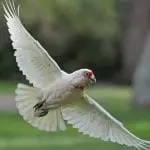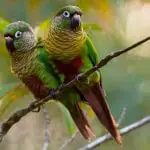Scientific Facts
| Common Name | Red Siskin |
| Scientific Name | Spinus cucullatus |
| Lifespan | 4 – 8 Years |
| Size | 3.9 inches |
| Mass | 9 grams |
| Habitat | Forest edges, grasslands with shrubs and trees, open country |
| Range | Northern South America |
Information & Physical Appearance
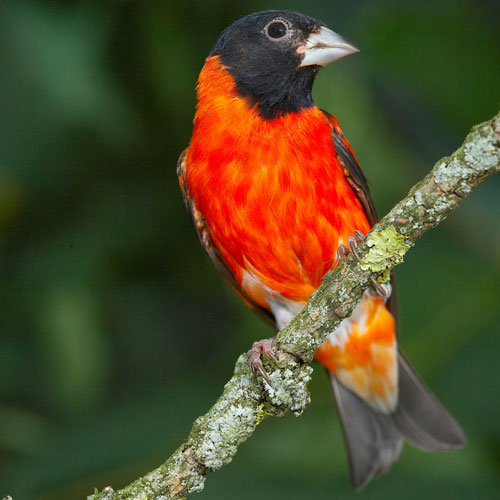
Scientifically referred to as Spinus cucullatus, the red siskin is a small-sized, vividly colored finch displaying beautifully contrasting red-and-black colors. It is part of the order Passeriformes, the family Fringillidae, the subfamily Carduelinae.
The male red siskin’s belly, under-tail coverts, and breasts are characterized by a vibrant, rich, deep red plumage. Also, red does appear on the wing bars, the upper-tail coverts, and the rump. On the back of the neck and towards the back’s length, the red coloration gradually blends to gray.
Meanwhile, black coloration is dominant on the throat, chin, the head, the tail, and the flight feathers.
The adult female red siskin’s coloration is visibly duller, in contrast with the brightly colored males. However, females do hold similar markings as those of males, with the major exception being the lack of the black hood typical in males.
In females, the red coloring appears exclusively on the breast, and in particular, on the upper portion of the breast. On the wing bar, the red coloration is faded, and so is the red coloration on the rump.
Juvenile red siskins display gray coloration, with immature males being more brownish rather than red, and immature females being paler in general. They start molting their plumage once they turn between 3-4 months of age. As red siskins mature, the red color is to deepen accordingly.
Lifespan
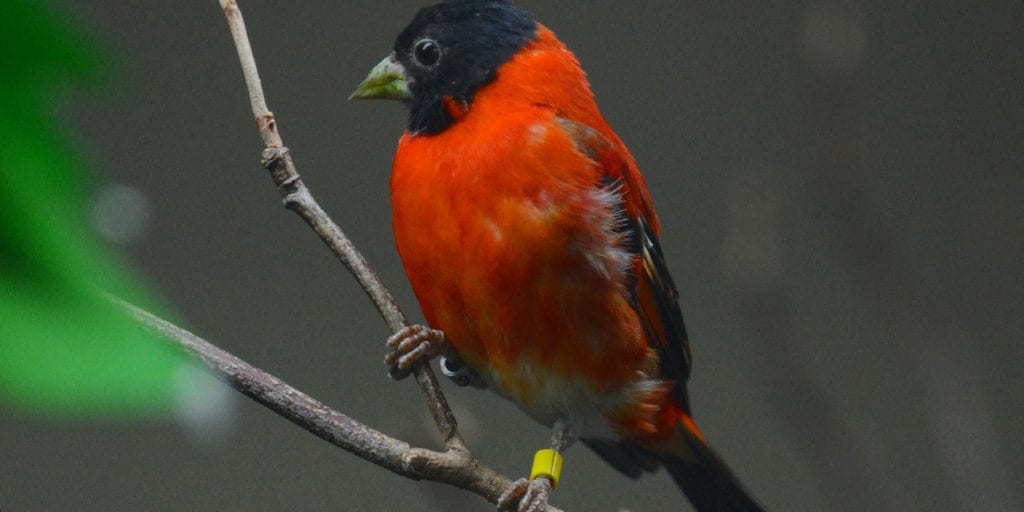
The average lifespan of the red siskin in the wild is estimated at 4.2 years.
However, when it comes to captive red siskins that are taken proper care of in human-managed environment, red siskins have a life expectancy of up to 8 years, making them some of the hardiest birds.
Ecosystem & Habitat
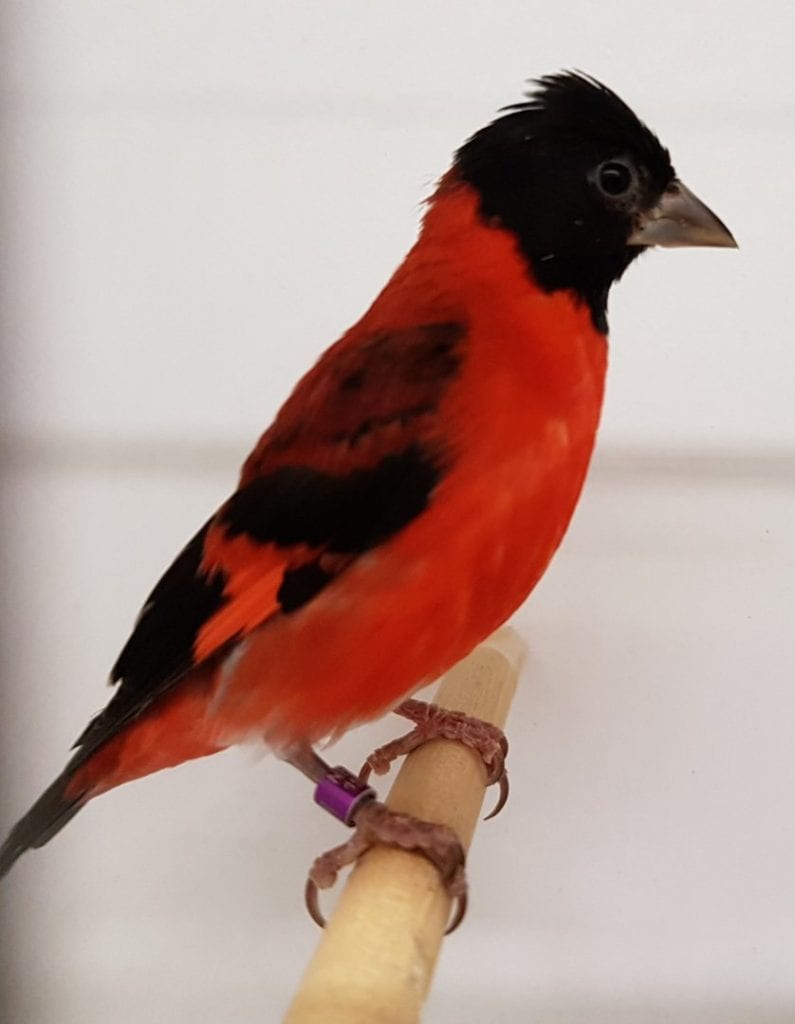
Red Siskins are known for using a wide variety of habitats located in the very foothills of northern Venezuela. The preferred type of habitats consists of deciduous forests, as well as tropical wet mountain forests. Also, spiny scrub forest-savanna regions are inhabited by this bird species.
The red siskin favors relatively dry, open forests, situated at elevations of between 1312 and up to 4593 feet.These birds are to migrate accordingly, based on seasonal precipitation.
As compared with much of its historical range, the current range of the red siskin has become harshly fragmented. Nowadays, only several hundred individuals make up for the very few isolated colonies of red siskins that still remain in the wild.
Up-to-date, any possible sightings of red siskins are considered extremely lucky and fairly rare. Such sightings are restricted to only four states in Venezuela. In the past, 15 states in Venezuela granted the chance for spotting red siskins in their natural habitat.
There is a persisting population of red siskins in Puerto Rico, consisting of escaped cage birds. However, according to experts, sightings have become extremely rare recently. It is in neighboring north Columbia where a small population of the red siskin is known to persist, too.
Although considered nationally critically endangered in Venezuela, a new population of red siskins was discovered in the southwest parts of Guyana back in 2000.
Food & Diet
Red siskins thrive on a plant-based diet. Their diet includes flower buds, fruit, herbaceous plants, as well as grass.
When it comes to captive red siskins, these birds are known to thrive when provided a balanced, varied diet consisting of thistle seeds (aka niger or nyjer seeds), canary seed mixes, and finch seed mixes. Red siskins that are kept as pets should also receive various types of lettuce, and nonetheless, a commercial pellet diet that is rich in minerals and vitamins.
Reproduction
The main reproductive period of the red siskin is known to occur between April and the beginning of June. Also, there is a secondary breeding period that occurs between November and December.
Being seasonal breeders, red siskins produce three and up to four eggs per single clutch. The eggs are white, with red speckles.
Red siskins build their nests in the shape of an open cup, typically placing the nest high in tall trees’ clusters.
It takes between 12 and 14 days for the eggs to hatch.
It is solely the female’s duty to provide all of the food needed for the newly hatched, small-sized chicks to survive and develop. Within 12 days after hatching, the chicks are to become fully feathered.
The young red siskins will be able to fledge in about 3 weeks, yet they will proceed being fed by the parents for another 2 and up to 3 weeks, while they are learning how to provide food for themselves on their own.
Even though it is exclusively the female to feed the young chicks in the nest, both parents are to share feeding responsibilities when the young leave the nest.
Captive Breeding
The breeding process of red siskins in captivity requires an in-depth understanding of this bird species.
Once the breeding season begins, this is the time to provide the breeding pair with a more varied diet. It is a varied diet that helps to wake up their natural breeding instincts.
If the conditions are suitable, these birds can breed all year-round. Canary breeding cages will work excellent.
Breeders can make use of a canary nest that is 40 mm across quite successfully with red siskins. In addition to that, the female requires a variety of nesting materials, e.g., coconut fiber, feathers, soft bark, swamp grass, and cotton wool.
During the entire breeding process, it is a must to increase live food, as well as egg intake and biscuit formula. Doing so is especially crucial in the period when the young chicks are still fed by their parents.
Health Risks, Survival Threats and Conservation
Similarly to other finches, the red siskin may suffer from health issues caused by an avian poxvirus, parasites, fungal infection, conjunctivitis, and enteritis, among others.
The population of red siskins has drastically declined in modern-day times. While these birds used to be commonly spotted throughout the foothills of the northern parts of Venezuela, nowadays, the sightings of this amazingly colored bird species are continuously becoming rarer and rarer.
Ever since 1952, the red siskin has been classified as endangered by the IUCN Red List of Threatened Species. Furthermore, red siskins are protected under the CITES Appendix I and were listed in the U.S. Endangered Species Act.
In particular, there are two human activities to have brought red siskins at the brink of extinction, namely habitat destruction and trapping. For many years back in time, these birds have been commonly trapped because of their alluring red plumage.
Furthermore, in the early twentieth century, the red siskins’ feathers were considered an especially fashionable item. In fact, sometimes even the whole bird was used for the purpose of decorating various clothing articles, such as women’s hats.
Also, in order for the “red factor” canary variety to be produced, domestic canaries and red siskins were deliberately hybridized. Thus, because of this avicultural practice becoming especially popular at the beginning of the 20th century, a dramatic decline of this bird species occurred.
Tragically, most of the red siskins died during the course of their transit across the ocean. To preserve the market for wild-caught red siskins, traffickers only provided males as to limit any possible attempts for propagating these birds in captivity.
Up-to-date, illegal trapping, as well as the illegal pet trade of Red Siskins, remain the primary threats to the survival of this amazing species.
Habitat loss is yet another serious threat to the survival of the red siskins in the wild, especially since these birds prefer to live in areas inhabited by humans. In addition to that, part of the natural habitat of the red siskins has been transformed for agriculture, logging, and, nonetheless, human activities.
On the bright side, field research has suggested that red siskins are capable of tolerating a wide variety of human activities. Therefore, no matter how limited in size, the remaining habitat might succeed in supporting larger populations in the future, provided that conservation efforts are to be applied in an adequate, timely manner.
Unfortunately, in the case that the red siskin populations continue to decline, this can pose additional threats to the survival of the species, more specifically inbreeding and loss of genetic diversity.
The loss of genetic diversity can greatly reduce the species’ ability to adapt to change. Inbreeding can reduce the species’ fertility, as well as disease resistance.The red siskin is a major part of Venezuela’s national identity. Sadly, it is nowadays regarded as one of the most endangered bird species on the planet.
Availability – Where to Get a Red Siskin
One can get a red siskin both online, as well as offline. Red siskins are available for sale at various pet stores, as well as directly from breeders. It is also possible to admire these feathery creatures at aviculture exhibitions.
Only acquire a red siskin from reputable vendors who can provide a guarantee of the bird’s captive-bred origin.
Purchasing wild-caught red siskins are not only illegal as the birds are protected by the law, but it is also immoral considering the endangered status of the species. By purchasing wild-caught red siskins, you are to support corrupt practices by contributing to the further decline of this species.
If anyone is to offer you a wild-caught red siskin for sale, please, immediately contact a conservation officer.
Interesting Facts
1. Red siskins are close relatives to the “red factor” variety of canary. It was thanks to the hybridization of domestic canaries and red siskins how the “red factor” canary was brought to life in the early 20th century. The red factor canary remains one of the most popular cage birds up-to-date.
2. The red siskin’s vocalization is described as a delightful series of chatters and trills. The call is a raspy “jut-jut.”
How to Care for the Red Siskin
To take the best care for the red siskins means finding a way to help save the birds from becoming extinct. Every single person has the power to significantly contribute to preserving this incredible bird species for generations to come.
1. Embrace an environmental-friendly mindset and lifestyle. Only choose products that are made with sustainable ingredients. Support and/or join communities that are striving to limit their negative impact on wildlife.
2. Be a smart consumer. Consider reducing, reusing, repurposing, and refurbishing. Avoid fast fashion. Consume less meat. Drive your car less and choose public transport or zero carbon footprint alternatives, such as riding a bike, instead.
3. Support organizations engaged in the protection and conservation of the red siskin, such as the Smithsonian’s National Zoo and Conservation Biology Institute. You can donate part of your time, goods, or money in order to be of assistance. Also, the Red Siskin Initiative aims to protect the recently established Red Siskin population in Guyana, as well as to restore sustainable populations through the reintroduction of this bird species in Venezuela, the initiative being an international partnership of both private and public institutions alike.
4. Share the story of the red siskin with others. It may seem like a very small step, but something as seemingly simple as raising awareness can actually greatly contribute to the overall protection of this incredible species.
5. Advocate for protecting the environment while you are on vacation, where you can get to meet with many people, thus, further spreading awareness and supporting ecotourism.
To take proper care of captive-raised red siskins, the birds should be provided a properly sized cage and a balanced diet.
Red siskins will do great in a planted aviary.
Remember that these birds come from a warm to the hot, tropical environment, and therefore, they should not be exposed to low temperatures.
Water
Clean, fresh water should be available at all times.
Plant Food
Feeding high-quality seeds is crucial for captive red siskins.
A good quality finch mix should do just fine; however, extra niger seeds (aka thistle or nyjer seeds) should be supplied in a separate feeder as they are extremely important, and should be provided at a higher ratio when compared to other seeds.
Other seeds to feed a red siskin with include maw, hulled oats, crushed sunflower seed, lettuce seeds, yellow millet, linseed, clover seed, radish seed, carrot seed, turnip seed, black rapeseed, red millet, chia seed, spinach seed, ryegrass seed, slender fescue grass seed, sesame seed, hemp seed, cocksfoot grass seed.
Feed seeds all year-round. If available, provide sprouted or soaked seeds regularly.
Also, mind that greens are especially important for red siskins. Provide leafy greens and leafy green vegetables such as chickweed, clover, silverbeet, lettuce, spinach, Lebanese cucumber, dandelion, flowering heads of milk thistle, seeding grasses, and endive.
Occasionally, offer fruits, such as apple, mango, pineapple, etc.
Live Food
Mealworms, fly pupae, crickets, small locusts. Feed live food all year-round. Egg and biscuit formula should be best added when feeding live food to red siskins, too.
Important Note
Provide extra live food/protein during the molting and breeding periods.
Vitamins
Supplement vitamins via the water supply.
Millet sprays
It is highly recommended to provide red and/or white panicum, as well as fresh seed on the stem French white millet.
Grit
Provide a high-quality mix consisting of shell, baked egg shell, charcoal, crushed cuttlebone, limestone.
FAQ Section
What Does a Red Siskin Look like?
The Red Siskin is a vividly colored, small finch, reaching about 3.9 inches in length and exhibiting bright black and red coloration. Females are duller colored than the males.
How Do You Breed Red Siskins?
To breedred siskins in captivity, the birds should be provided a varied diet at the very start of the breeding season to encourage their breeding instincts. Also, a canary nest that measures 40 mm across, as well as nesting materials, should be provided.
Is the Red Siskin Endangered?
Yes, the red siskin is listed as Endangered on the IUCN Red List of Threatened Species and is only one step to being listed as Critically Endangered. The population trend is decreasing, with only as few as 1500 – 7000 mature individuals remaining in the wild based on the global 2018 assessment.
Why is the Red Siskin Endangered?
The red siskin is endangered with extinction because of human activity, in particular, hunting and trapping, as well as habitat degradation driven by agriculture and aquaculture practices.


